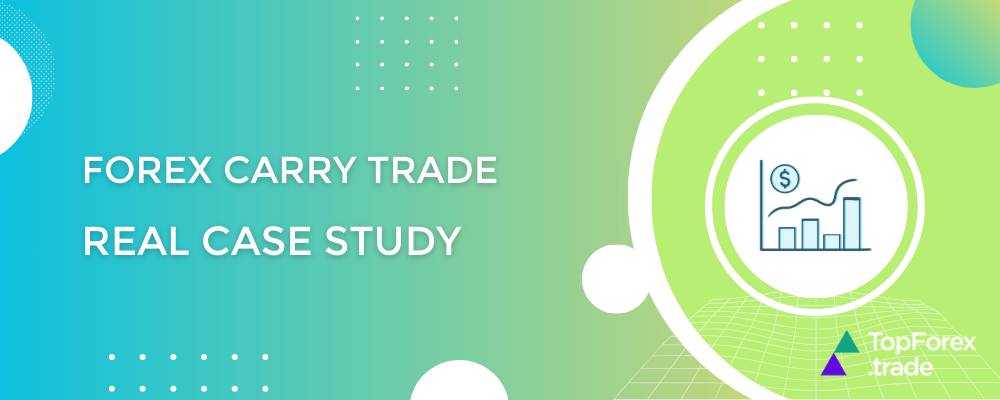Carry trade strategies: how to profit from interest rate differentials

Carry trade is one of the most intriguing strategies in Forex trading, where traders take advantage of the difference in interest rates between currencies. Essentially, you borrow in a currency with a low interest rate and invest in one with a higher rate, pocketing the difference. It sounds simple, but to truly master it, you need to understand the right indicators, timing, and risk factors. In this article, we’ll dive into how carry trades work, share some real-life examples, and break down a case study to show how this strategy can play out in the market. Plus, we’ll point you to the best Forex brokers that make carry trading possible.
What is carry trade?
Carry trade is a Forex strategy where traders borrow in a low-interest-rate currency and invest in a higher-yielding one, earning from the interest rate difference. Traders profit from the difference in interest rates between the two currencies, a concept known as the “interest rate differential.” This strategy can be particularly lucrative when interest rate differentials are wide, but it also carries risks, especially if currency values fluctuate unexpectedly.
How carry trade works

Here’s a step-by-step breakdown of how a carry trade works:
-
Choose the currency pair: Identify a currency pair with a significant difference in interest rates between the two currencies. Common pairs for carry trades include:
- AUD/JPY (Australian Dollar/Japanese Yen)
- NZD/JPY (New Zealand Dollar/Japanese Yen)
- USD/TRY (U.S. Dollar/Turkish Lira)
-
Borrow in the low-interest-rate currency: You borrow the currency with the lower interest rate (e.g., JPY, CHF, or EUR).
-
Invest in the high-interest-rate currency: You use the borrowed funds to buy the currency with a higher interest rate (e.g., AUD, NZD, or BRL).
-
Earn the interest rate differential: You earn interest from the higher-yielding currency while paying interest on the borrowed currency. The difference between the two is your profit, assuming no drastic currency movements.
-
Managing risk: Carry trades can be profitable if the market stays relatively stable, but they become risky if the value of the higher-yielding currency drops or if there’s a shift in interest rates.
Examples of carry trades
-
AUD/JPY carry trade example:
- Interest rates: Australia has an interest rate of 2.5%, while Japan’s interest rate is 0.1%.
- The trade: A trader borrows 1,000,000 JPY at 0.1% interest and buys AUD with that money.
- Return: The trader earns 2.5% on the AUD investment while paying 0.1% interest on the JPY loan, making a net return of 2.4%.
-
USD/TRY carry trade example:
- Interest rates: The U.S. has an interest rate of 0.25%, while Turkey’s interest rate is 19%.
- The trade: A trader borrows USD at 0.25% interest and buys Turkish lira (TRY), profiting from the 18.75% interest rate differential.
These examples highlight how traders can earn significant returns from the interest rate differential, especially when the gap between interest rates is wide. However, it’s important to note that currency fluctuations can reduce or eliminate the profitability of the trade.
Key technical indicators for carry trades

While carry trades primarily focus on the interest rate differential, technical analysis can still play a role in managing the risks and timing of the trade. The following indicators can be useful for assessing the market conditions for carry trades:
-
Moving Averages (MA):
- Moving averages help identify trends. A trader can use a 50-day and 200-day moving average to determine the direction of the currency pair. If the shorter moving average crosses above the longer moving average, it signals an uptrend, which is favorable for carry trades involving a higher-yielding currency.
-
Relative Strength Index (RSI):
- RSI is used to measure the momentum of a currency. If the RSI shows that the higher-yielding currency is overbought, it may indicate that the market is near a reversal, signaling that the carry trade could face headwinds.
-
Bollinger Bands:
- Bollinger Bands are helpful for identifying volatility. If the bands are narrow, it indicates low volatility, which is a safer environment for carry trades. If the bands widen, it suggests higher volatility, which may lead to unexpected currency movements.
-
Interest Rate Futures:
- For carry traders, monitoring interest rate futures can be crucial. If a central bank is expected to raise rates, the value of the currency with the higher yield can appreciate, enhancing the profitability of the carry trade.
-
MACD (Moving Average Convergence Divergence):
- MACD is another trend-following indicator that can help traders identify the momentum of the currency pairs they are trading. A strong MACD signal can help confirm a carry trade position.
Real carry trade case study
Case study: AUD/JPY carry trade using HF Markets
Context:
In 2018-2019, the Reserve Bank of Australia maintained interest rates around 1.5%, while Japan’s Bank of Japan kept rates near 0.1%. This created a favorable environment for a carry trade using the AUD/JPY currency pair.
The trade setup:
- A trader using HF Markets borrowed 1,000,000 JPY at 0.1% interest.
- They converted the borrowed amount into AUD, which offered a 1.5% interest rate.
- Holding the position over time, the trader collected the interest rate differential of 1.4% while monitoring currency fluctuations.
Outcome:
- Since the AUD/JPY exchange rate remained stable during the period, the trader successfully earned the interest rate differential.
- HF Markets provided low spreads and strong liquidity, making it easier to execute and maintain the trade profitably.
Top FX brokers for carry trade
When executing carry trades, it’s essential to choose the right broker. Not all brokers offer the same conditions, so it’s important to look for those that support carry trades effectively.
Here are some of the top brokers for carry trading:
HF Markets FX trading
HF Markets offers competitive spreads and margin trading, making it ideal for carry traders. They provide a wide range of currency pairs with significant interest rate differentials.
AvaTrade FX trading
AvaTrade supports carry trading strategies with a variety of currency pairs and offers low-cost spreads. They also provide access to a range of trading platforms and tools for effective analysis.
XTB FX trading
XTB offers low spreads and high leverage, making it suitable for carry traders. They also provide excellent customer service and educational resources for traders of all experience levels.
Exness FX trading
Exness is known for its low spreads and flexible margin requirements, which can be beneficial for those engaging in carry trades. They also offer a range of currency pairs with favorable interest rate differentials.
eToro FX trading
eToro is a popular social trading platform that allows traders to mirror successful strategies, including carry trades. Their platform is user-friendly and supports a wide range of currency pairs.
Risk disclaimer: eToro is a multi-asset platform which offers both investing in stocks and cryptoassets, as well as trading CFDs.
CFDs are complex instruments and come with a high risk of losing money rapidly due to leverage. 61% of retail investor accounts lose money when trading CFDs with this provider. You should consider whether you understand how CFDs work, and whether you can afford to take the high risk of losing your money.
This communication is intended for information and educational purposes only and should not be considered investment advice or investment recommendation. Past performance is not an indication of future results.
Copy Trading does not amount to investment advice. The value of your investments may go up or down. Your capital is at risk.
Don’t invest unless you’re prepared to lose all the money you invest. This is a high-risk investment and you should not expect to be protected if something goes wrong. Take 2 mins to learn more.
eToro USA LLC does not offer CFDs and makes no representation and assumes no liability as to the accuracy or completeness of the content of this publication, which has been prepared by our partner utilizing publicly available non-entity specific information about eToro.
Related articles:
FX carry trading - FAQ